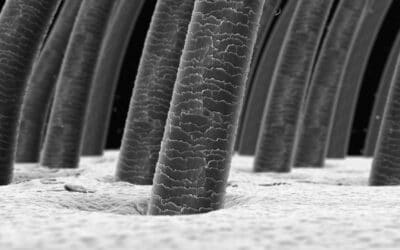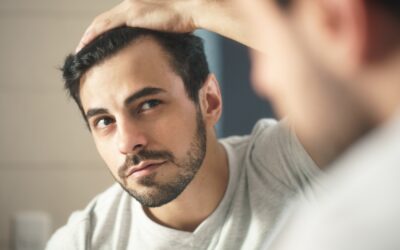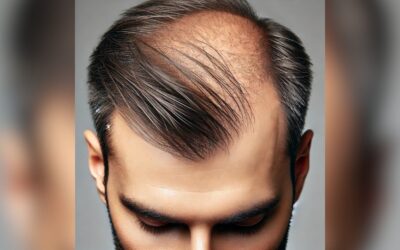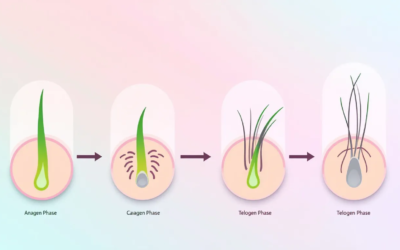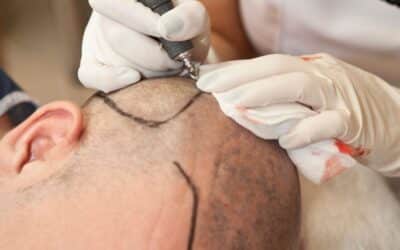There is a common misconception that when someone suffers from crown of head hairloss, the hair is harder to regrow than on other areas of the head. It’s easy to understand why some people would believe this misconception. The crown of the head isn’t an area of the body that is readily apparent. Most of us don’t regularly bend over while looking in the mirror to examine the top of our heads. So, when we do notice crown of head hairloss and start in on our hair restoration journey, it seems like the hair on the crown is regrowing slower. And let’s be fair. It’s harder to notice and keep tabs on than hair at the hairline or side of our head.
When crown hairloss starts to happen, it’s after hair loss occurs at the hairline and other places on the scalp. However, everyone loses hair differently, so this is not always the case. Whether male or female, the progression of hair loss is never the same for anyone. When you start to lose hair on the crown of your head, if you don’t spot it right away, then treatment may be more difficult as the hair loss progresses. Just like any other progressive condition, early detection and treatment are important. After all, the longer you let it go the harder it will be to treat.
Treating Men & Women with Crown of Head Hairloss
Here at Best Hair Transplant Los Angeles, we are an LA FUE clinic and have treated many different causes of hair loss on the crown of the head, and for both men and women. The first step in treating top of head hairloss is to establish what the cause of the hair loss is. Then, our doctors can offer a hair restoration option that would be the most effective to combat your crown of head hairloss. If you’re ready to learn about what’s causing your hair loss, this article is for you!
Alopecia and Its Many Forms
The most commonly used term for hair loss is “alopecia.” This is an overall term that labels many different kinds of hair loss for a variety of different reasons. Normally, people lose around 50 to 100 individual hairs per day, just carrying about their normal business. This is a natural part of the self-renewing process our hair goes through as old hair falls out and new hair begins to regrow on our scalps. Alopecia occurs when that hair falls out and new hair fails to re-grow.
There are many different types of alopecia. Many of them will cause crown of head hairloss and identifying what form of alopecia you suffer from is the first step in coming up with an effective treatment.
Androgenic Alopecia
The first and most common type of alopecia that affects both men and women is androgenic alopecia. Also known as male or female pattern baldness, androgenic alopecia is by far the most common reason for someone to seek out an FUE clinic like Best Hair Transplant Los Angeles.
If you are a woman, it’s common for androgenic alopecia to thin your hair over most, if not all of your scalp instead of just around the hairline or the crown of your head. The first sign of androgenic alopecia in women is a widening of the part in their hair. If you are a man, then this form of alopecia will normally result in a recession of your hairline followed by hair loss on the crown of your head. If left untreated, in men it will generally result in complete or partial baldness.
Research has shown that androgenic alopecia is caused by a hormone in the body called androgens, particularly an androgen called dihydrotestosterone. Androgens play a critical role in male sexual development during puberty as well as other important functions in both males and females. When there is an increased level of androgens in the body, then the normal growth cycle of your hair follicles is shortened, as well as a delay in the process after the hair falls out of the hair follicle. (Medicine, n.d.).
Alopecia Areata
This form of alopecia is also known as “patchy baldness” and is an autoimmune disorder. In most cases of alopecia areata, hair will fall out of the scalp, and sometimes other parts of the body, in small patches that are about the size of a quarter. The amount of hair loss is different with each case, some are severe while some suffer only a few patches of hair loss. In rare cases, it could lead to complete baldness on the scalp or even all over the entire body (alopecia totalis).
Alopecia areata occurs when the white blood cells in the body mistake a person’s hair follicles for foreign invaders. This causes the hair follicles to shrink and dramatically slow down hair production. Similar to most autoimmune disorders, scientists do not know what causes the white blood cells to behave in this manner, although family genetics are known to play a part in it. One in five people with the disease has a family member who has also developed alopecia areata and if you have other autoimmune disorders in the family, the likelihood of alopecia areata occurring is greater.
It’s worth noting that most people suffering from Alopecia Areata will not benefit much from an FUE or FUT hair transplant. That’s because this autoimmune disorder may continue attacking new hairs, even when there are hairs available for transplantation. That’s why we tell patients that hair transplants are not a cure for Alopecia Areata.
Alopecia Totalis
Alopecia totalis is the above-mentioned form of alopecia areata when all of the hair on the body falls out completely. This includes eyebrows, eyelashes, body, and pubic hair. This is the most severe form of alopecia areata, and is also known as alopecia universalis.
Traction Alopecia
Traction alopecia is neither a genetic condition nor an autoimmune disorder. Instead, traction alopecia is caused by constant stress and friction on the hair by repeated pulling and stretching. Generally, traction alopecia occurs when someone consistently wears their hair in tight braids, ponytails, dreadlocks, weaves, and when using hair extensions. Over time, these hairstyles permanently damage the hair follicles and cause them to cease the regrowth process. A common symptom of traction alopecia is short, broken hairs sticking up on the fringes of the braids or ponytails.
Cicatricial Alopecia
Cicatricial alopecia is also known as “scarring alopecia” and is caused by inflammation of the scalp. This inflammation can be caused by trauma like burns or a serious infection of the skin or can in rare cases flare up for no discernable reason whatsoever. The inflammation can involve different types of cells, including lymphocytes, natural killer cells, or several cell types all at once.
Cicatricial alopecia is known to affect both men and women but is rare in children. It occurs when the inflammation destroys the stem cells and oil glands of the hair follicle which leads to scarring. After the scarring occurs it makes it difficult for the hair follicle to grow through the scars and hair loss occurs. Sometimes cicatricial alopecia will occur slowly over time and sometimes it happens quickly, and the hair loss is rapid. Burning, itching, and red pustules are common signs and symptoms of cicatricial alopecia.
Types of Alopecia that Cause Crown of Head Hairloss
By far the most common type of alopecia that will cause crown of head hairloss in both men and women is androgenic alopecia. Generally, in men, this condition starts with a slight recession of the hairline. Then, over time, hair loss will begin to occur at the crown of the head. Androgenic alopecia will cause the hairline to resemble a M, V, or U shape. In women, androgenic alopecia normally causes a general thinning of the hair, which is most noticeable at the hair part, while the crown of the head will still retain hair.
Alopecia areata is another common form of alopecia that will cause crown of head hairloss. Instead of a gradual recession of hair, alopecia areata will cause hair to fall out in patches at the crown of the head. A common symptom of alopecia areata is when someone notices a change in their fingernails and toenails. The nails will start to show tiny little pit-like dents with white spots or lines.
Traction alopecia usually doesn’t affect the crown of the head, Normal signs of traction alopecia include a receding hairline around the forehead temples and nape. You will sometimes see small pimples appear on the scalp or base of the braids. However, depending on the particular hairstyle, traction alopecia can occur on the crown of the head. Hairstyles like a topknot worn tightly and in a regular manner may cause further complications.
Central Centrifugal Cicatricial Alopecia
There is a form of cicatricial alopecia known as Central Centrifugal Cicatricial Alopecia (CCCA), where permanent hair loss occurs in the crown region of the scalp. CCCA almost exclusively afflicts black women over the age of 30. Typically, it’s caused by inflammation and scarring of the scalp. Nearly 15% of black women experience CCCA but the actual number is unknown.
There are many different reasons that CCCA occurs. Recently, a gene variant was discovered in about 25% of patients with CCCA. However, the precise role that this gene variant has in CCCA is unknown. A non-cancerous tumor of the smooth muscle known as uterine fibroids might also have a role in CCCAA. Typically though, it’s commonly a mixture of hairstyles, infections (bacterial and fungal), genetics, autoimmune disease, and other unknown factors that play a role in this disease. (Crystal Aguh & Amy McMichael, 2020).
Treatments for Crown of Head Hairloss
Depending on the nature of your hair loss, there are several different types of treatments available to you. A Follicular Unit Extraction (FUE) hair restoration surgery is a sure-fire solution to most, if not all types of alopecia and other types of hair loss. Finding an FUE clinic like us here at Best Hair Transplant Los Angeles and signing up for a hair transplant could be the quickest and easiest way for you to get back your head of full, natural-looking hair.
Capillus LLLT
If you are not that quick to dive right into surgery, then there are less invasive hair restoration solutions available for crown of head hairloss. Low-Level Laser Therapy (LLLT) has had some very exciting research and studies conducted as a treatment for many types of alopecia. Here at Best Hair Transplant Los Angeles, we are not only an FUE clinic, but we also offer a product called the Capillus Laser Cap, that employs 312 LLLT diodes that you only must wear for 6 minutes a day for your treatments.
LLLT interacts with the cells of your hair follicles when the low-level laser, when set to a specific calibration, stimulates the underperforming follicles into a re-growth process. LLLT is both safe and effective when treating many different types of alopecia that affect the crown of the head and other areas of the scalp. (Pinar Avci, 2013). LLLT is a much less invasive alternative to a hair transplant Los Angeles surgery; however, if the hair follicles at the crown of your head are completely dead, then LLLT will do little to help you regrow your hair. In this case, an FUE procedure may be a better option for you.
Topical Hairloss Treatments
There are topical hair loss medications like Minoxidil (Rogaine) and Finasteride that studies have shown to be effective at slowing the progression of hair loss. There are even situations where these drugs may regrow lost hair. However, the results of these drugs, when used as a standalone treatment may disappoint you. Minoxidil and Finasteride are most effective when used at the very begging stages of alopecia and in combination with other hair loss solutions like an FUE hair transplant or LLLT.
Fight Your Crown of Head Hairloss at Best Hair Transplant LA
Our experts have seen and treated every kind of alopecia and hair loss that affects the crown of the head, and everywhere else on the scalp. It doesn’t matter if you suffer from androgenic alopecia, alopecia areata, or central centrifugal cicatricial alopecia, we have a solution for you that will be the best possible option based on your individual needs.
All our doctors here at Best Hair Transplant Los Angeles are hair loss experts and have performed hundreds of FUE hair transplants. We are a FUE clinic, but our treatments don’t just stop at surgery. If an FUE procedure isn’t the right option for you, we will guide you step by step to the right hair restoration option that will give you the results that you want.
Contact us today to set up a complimentary consultation with one of our experts.
SUFFERING FROM HAIR LOSS?
Best Hair Transplant is the best place to schedule your hair transplant in Los Angeles. We’ve helped both men and women regrow their lost hair. But don’t take our word for it. We suggest learning as much as possible about hair restoration. Do so prior to making a decision on how to address your hair loss. Not every procedure is right for everyone.
At Best Hair Transplant, we’re proud of our results and happy to provide hair restoration services. Additionally, we’re proud to make hair transplants affordable and help you save money on a variety of hair transplants.
To ensure your ease of mind, you can view our customer recommendations HERE. Furthermore, you can also see our Google reviews and Yelp reviews. We can’t wait to help you start restoring your lost hair.
YOUR HAIR RESTORATION SOLUTION
Best Hair Transplant
1970 S. Prospect Ave., Suite 2
Redondo Beach, CA 90277
(213) 403-0455
References
- Crystal Aguh, M., & Amy McMichael, M. (2020). Central Centrifugal Cicatricial Alopecia. JAMA Network.
- Medicine, N. L. (n.d.). Androgenetic alopecia. Retrieved from Medline Plus.
- Pinar Avci. (2013). Low-Level Laser (Light) Therapy (LLLT) for Treatment of Hair Loss. Lasers Surgery Medical.

